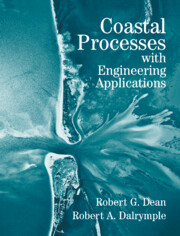Book contents
- Frontmatter
- Contents
- Preface
- Acknowledgments
- PART ONE INTRODUCTION TO COASTAL PROCESSES
- PART TWO HYDRODYNAMICS OF THE COASTAL ZONE
- PART THREE COASTAL RESPONSE
- PART FOUR SHORELINE MODIFICATION AND ANALYSIS
- 11 Beach Fill and Soft Engineering Structures
- 12 Hard Engineering Structures
- 13 Tidal Inlets
- 14 Shoreline Management
- Author Index
- Subject Index
14 - Shoreline Management
Published online by Cambridge University Press: 29 May 2010
- Frontmatter
- Contents
- Preface
- Acknowledgments
- PART ONE INTRODUCTION TO COASTAL PROCESSES
- PART TWO HYDRODYNAMICS OF THE COASTAL ZONE
- PART THREE COASTAL RESPONSE
- PART FOUR SHORELINE MODIFICATION AND ANALYSIS
- 11 Beach Fill and Soft Engineering Structures
- 12 Hard Engineering Structures
- 13 Tidal Inlets
- 14 Shoreline Management
- Author Index
- Subject Index
Summary
Hurricane Hugo, a Category 4 storm, made landfall slightly north of the entrance to Charleston Harbor, South Carolina, in September 1989. The storm tide, based on high water marks, peaked in excess of 20 ft, which is second only to the 22.4-ft. storm tide caused by Hurricane Camille (1969) at Pass Christian, Mississippi.
The development along the impacted area of South Carolina had taken place over several decades under generally inadequate structural and setback controls. Moreover, the erosion rates on some portions of the South Carolina shoreline are moderately high, causing older structures to be near the shoreline.
Although no structures built to modern standards suffered major damage, Hurricane Hugo destroyed or caused severe damage to in excess of 15,000 structures. Of these, about 150 were considered to be unbuildable under the management policies in place at the time. (Shore & Beach, 58, 4, 1990, has a number of articles about Hugo's effects.) There has been considerable litigation over whether and under what conditions these structures should be rebuilt. The total damages caused by Hugo exceeded $4.0 billion.
With most of the U.S. shoreline heavily developed, the preceding scenario will recur, and it is important that national and local management policies be in place to regulate construction near the shoreline and reconstruction following storms so that future disaster liabilities and personal hardships will be minimized.
INTRODUCTION
The current pressure for development along much of the nation's shoreline, coupled with the prognosis for increased rates of sea level rise (Chapter 3) and the possibility of increased storminess due to the Greenhouse effect, have raised questions about the most appropriate policies for coastal zone management.
- Type
- Chapter
- Information
- Coastal Processes with Engineering Applications , pp. 452 - 464Publisher: Cambridge University PressPrint publication year: 2001



